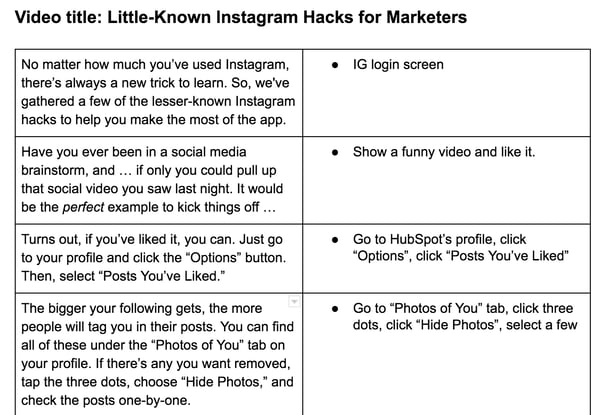Based on our research, the need for video in B2B marketing to engage with your audience is clear. As a result, you’ve decided to incorporate video into your marketing strategy. After reviewing our guidelines to determine the point in the buyer’s journey where you want to engage potential customers with video, a great place to start is typically a corporate video, or a product or service overview video. But now what?

Like any piece of marketing content, video should begin with your writer putting pen to paper (or more likely, fingers to keyboard) to develop the content, or script, for the video. Let’s pause here. We know the negative connotations that come to mind when we say the word “script.” No one wants to watch a video that sounds “scripted” (and we will provide tips later on how to avoid doing this). However, to ensure you stay on message and provide information in a clear and concise manner, it’s critical to develop a thorough script upfront.
The most manageable approach to developing a video script starts with creating a detailed outline based on the goals your team set for the video. Here is an outline to follow when developing a script:
- State the problem – Connect immediately with your audience by recognizing the challenge they’re facing.
- Show what is causing this problem – Technical audiences want to understand why something happens – so build trust by showing them you understand what isn’t working.
- Provide data – Support the fact that this is a problem with data.
- Make the problem bigger – Show where viewers like them end up if they don’t address the problem (you can swap steps 3 and 4).
- Introduce your company – Now that you’ve piqued the viewers interest, start to talk about your brand, product, or service as a solution to the problem.
- Explain how other companies address this – Include what the audience may miss by working with someone else or taking a traditional approach.
- Detail how you are different – Explain the process you use, your expertise in a service area, or unique features of your product or service and address any common misconceptions.
- Highlight results – Share what potential customers can expect to get from working with you. A short customer testimonial could be used here instead.
- End with a call to action – Tell viewers the next step they can take to solve their problem.
Since you typically only have a few seconds to engage a viewer and entice them to continue watching your video, we encourage using this format. This approach leads with what is important to the viewer (their problem) rather than what’s important to you (introducing yourself, your company, or your product or service). By leading with customer pain points, you can make an impactful opening statement that can clearly resonate with the viewer.
Let’s look at an example from Infinitum Electric, a company that re-engineers critical aspects of traditional motor technology, helping customers gain a competitive advantage with differentiated products that decrease carbon footprint and improve performance, reliability, and cost.
The corporate overview video on Infinitum’s site follows the outline proposed above.
Here is a breakdown of how they followed this approach and incorporated each element into their script:
- State the problem – Electric motors use over half the world’s electricity every year.
- Show what is causing this problem – Existing electric motors run on technology that’s ancient – 100 years old. It’s inefficient and cumbersome.
- Provide data – Atmospheric CO2 levels are the highest they’ve ever been.
- Make the problem bigger – Atmospheric CO2 levels will continue to skyrocket.
- Introduce your company – Infinitum Electric is taking on an electric motor revolution with a completely new approach to motors.
- Explain how other companies address this – Traditional motors have an iron and copper core.
- Detail how you are different – We etch copper conductors into a silicon-based stator. Our design features:
- A mix-and-match modular approach
- A lighter alternative
- A lighter result
- Less raw material requirements
- Simple manufacturing
- Streamlined installation
- Highlight results – We bring:
- Higher performance
- Higher efficiency
- Less energy consumption
- 10 percent energy savings
- Potential elimination of up to 860,000,000 metric tons of CO2 per year
- End with a call to action – This video is housed on the company’s homepage, so it ends with a simple logo. If hosted offsite or shareable (Youtube, LinkedIn, etc.), they would add their company URL.
Four Tips for Developing a Clear, Concise, and Conversational Video Script
After you have your outline, it’s time to start writing your script. And to be clear, when we say writing the script, we really do mean putting every spoken word down on paper. While there are some instances where ad hoc and non-scripted video may make sense, you are more likely to stay on message, need less editing, and communicate concisely when you start with a comprehensive script.
To help with this, here are four tips for developing video script that doesn’t sound like a script and how to avoid getting overwhelmed by the fact that the content you are writing is for video.
1. Less is More
In general, a video should be 90 seconds to two minutes max. Naturally, you will want to pack as much as possible into that short time. However, less is truly more when it comes to what is said in a video, so it’s best to develop a focused message and write a script that uses short sentences that will land firmly with viewers. A good guideline to follow is to have video subjects speak at a cadence of around 150 words per minute. This translates to a written script between 225 and 300 spoken words – much shorter than your average blog post. To ensure your video subjects won’t try to work around this and fit more in by talking faster, don’t write a script, and then see how long it turns out when recording. Use the estimate above and write to the time allotment set for the video.
2. Define Your Story Before Getting Wrapped up in the Visuals
It’s easy to get overwhelmed by video, especially if you try to think about the visuals before defining your story. One common misconception is that every video needs a professional hand-sketched storyboard like this:

In reality, a script that includes detailed visual cues instead is actually just as good, if not better. Take this example script from HubSpot:

While drafting the script, the writer made pretty detailed notes on the visuals that should be shown while the video narrator is speaking. Notice how the second suggestion is vague. While being thorough is important, not all the visual details need to be fully worked out in the script. The perfect shot can be developed later based on what is being said in the video.
Additionally, while this example is for a video that uses a voiceover with related visuals, the same approach should be used for any type of video. If the video will require multiple shots, characters, scenes, B roll, or any other type of footage, include information about the visual that will fit with the script and at what point in the script the transition should happen.
No matter what type of video you are creating, just remember to start with the content. If you start with the imagery, oftentimes you will find yourself using your words to describe the image instead of saying your message.
3. Your Video Needs to Match the Tone of Your Company
Whether you are developing video for a product or service or a testimonial, a video is a real chance for potential customers to get a feel for what it would be like to work with you. Therefore, you want the content and imagery conveyed in the video to match the tone you’ve set for your company. This all comes back to knowing the persona you are speaking to with your marketing content. At TREW Marketing, we talk to engineers. Therefore, we focus on conveying facts and data, but in a relatable way, and that needs to come through in any video we produce for our audience.
4. Write and Rehearse Conversationally
A video script needs to be written how you speak, not how you write. And while you may already focus on incorporating casual tone into content such as blog posts, there are nuances such as pauses and verbal explanations that you will need to incorporate into content that someone will say that you would not need to do if it the words just stay on paper. This is best achieved by keeping sentences short and crisp.
Additionally, no matter who is speaking on camera, they should speak in a way that feels relatable to your clients. You want them to sound conversational, not robotic. Reading your script out loud as you develop it provides opportunities to make the language more conversational (good thing most of us are working from home now, right?). Advise your speaker to read and re-read the script and add or takeaway words and pauses to make the script flow better with their voice.
TREW is a marketing agency dedicated to reaching engineering and technical audiences through a range of marketing initiatives. Contact us today to learn more about the services we offer.
SUBSCRIBE TO OUR BLOG FOR THE LATEST UPDATES
Jamie Tokarz
 Jamie has more than 15 years' experience writing technical marketing content designed to engage client’s target audiences. She enjoys the challenge of taking a highly technical topic and communicating it in a manner that makes it relatable to non-domain experts. Jamie holds a bachelor’s degree in public relations and journalism from Utica College of Syracuse University and master’s degree in Advertising from the University of Texas at Austin. Originally from upstate NY, Jamie now lives in the mountains outside of Denver, CO.
Jamie has more than 15 years' experience writing technical marketing content designed to engage client’s target audiences. She enjoys the challenge of taking a highly technical topic and communicating it in a manner that makes it relatable to non-domain experts. Jamie holds a bachelor’s degree in public relations and journalism from Utica College of Syracuse University and master’s degree in Advertising from the University of Texas at Austin. Originally from upstate NY, Jamie now lives in the mountains outside of Denver, CO.
About TREW Marketing
TREW Marketing is a strategy-first content marketing agency serving B2B companies that target highly technical buyers. With deep experience in the design, embedded, measurement and automation, and software industries, TREW Marketing provides branding, marketing strategy, content development, and digital marketing services to help customers efficiently and effectively achieve business goals.




 Jamie Tokarz
Jamie Tokarz